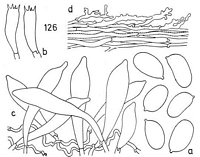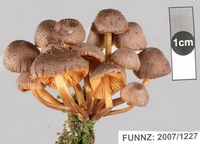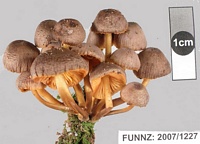|
 Mycena leaiana var. australis Mycena leaiana var. australis
SynonymsFlammulina glutinosa
Mycena leaiana
BiostatusPresent in region - Indigenous. Non endemic
Images (click to enlarge) | 
Caption: 126-Mycena leiana [Flammulina glutinosa Stevenson]: a. spores; b. basidia; c. cheilocysidia; d. cuticle. | 
Owner: J.A. Cooper | 
Caption: FUNNZ2007/1227
Owner: FUNNZ | |
Article: Stevenson, G. (1964). The Agaricales of New Zealand: V. Kew Bulletin 19(1): 1-59.
Description: Pileus 1.5-2.5 cm diam., hygrophanous, fuscous, striate at margin, drying to olive buff, convex with or without a central dimple, exceedingly glutinous; flesh thin, fuscous to buff. Gills sinuately adnexed to adnate, orange to deep chrome yellow, thin, moderately crowded. Stipe 2-3 cm x 2-3 mm, fuscous to olive buff or orange towards the top, exceedingly glutinous, hollow. Spores 8-9 x 5 µm, non-amyloid, hyaline, thin-walled (Fig. 12); print white; sterile gill edge of loosely woven hyphae and sonic balloon cystidia with clear yellow contents. Cystidia not seen on gill faces. Basidia normal, 6 x 20 µm.
Habitat: On fallen rotting wood, Otari, 12.7.1946, Tararuas, Levin, 3.5.1947 & 14.5.1948, Waikanae, 1.4.1949 (type), Levin, 22.6.1958; all Stevenson.
Notes: Although this fungus has no cystidia on the gill faces or surface of the cap its affinities appear to the writer sufficient to place it in Flammulina. It also appears to have affinities with Tricholomopsis in the yellow gills with sterile margins.
Article: Horak, E. (1971). A contribution towards the revision of the Agaricales (Fungi) from New Zealand. New Zealand Journal of Botany 9(3): 403-462 (http://www.rsnz.org/publish/abstracts.php).
Notes: Flammulina glutinosa Stevenson (29 D) Fig. 11 = Mycena leiana (Berkeley)
Saccardo.
This is a unique, glutinous, deep orange coloured Mycena known only from North
America. We compared the New Zealand specimen with material collected in the
U.S. and did not find a single character separating the two. It may well be that M.
leiana was accidentally introduced into New Zealand and should therefore be
tentatively included in the list of the adventitious fungi.
|